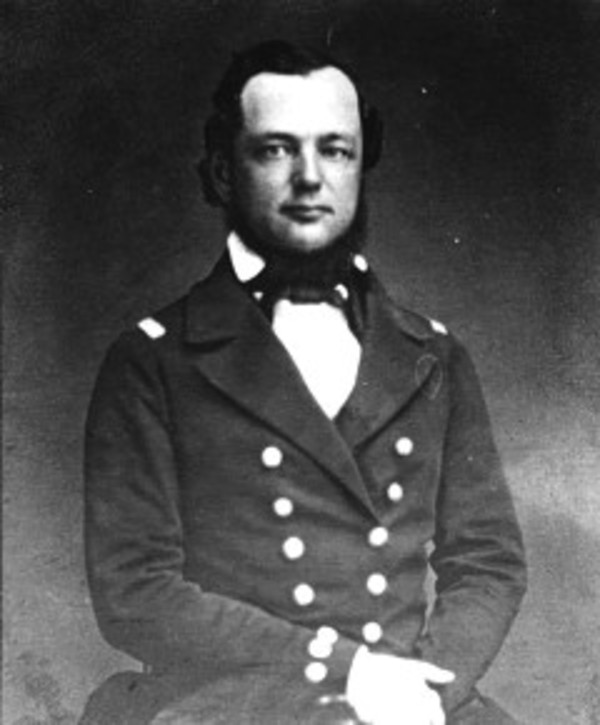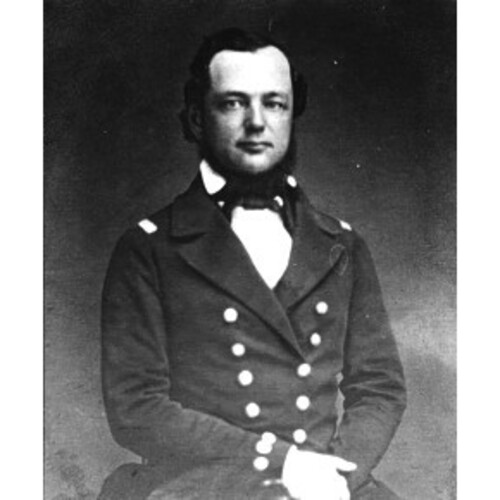
Source: Link
DE HAVEN, EDWIN JESSE, naval officer and explorer; b. 7 May 1816 at Philadelphia, Pa., son of William De Haven and Maria McKeever; m. in 1844, Mary Norris Da Costa; d. 1 May 1865 in his native city.
Edwin Jesse De Haven, who was of Dutch descent, entered the United States Navy on 2 Oct. 1829 as a midshipman. After serving on various ships in the West Indies, he was appointed in 1839 to the Vincennes, commodore ship of the discovery squadron of Commander Charles Wilkes, and spent the following three years in exploration in Antarctica, the Pacific islands, and on the west coast of North America. He received the thanks of the Navy Department for saving several lives when one of the expedition’s ships was wrecked at the mouth of the Columbia River, and he was commissioned lieutenant in September 1841. He was then attached to the Naval Observatory in Washington, D.C., under the celebrated oceanographer, Matthew Fontaine Maury, and served afloat during the Mexican War (1846–47).
Early in 1850 a wealthy New York merchant, Henry Grinnell, with the assistance of the United States government, equipped an expedition to share in the search for the lost ships of Sir John Franklin*; De Haven’s polar experience and his scientific attainments procured him its command. The first Grinnell expedition, consisting of the brigs Advance and Rescue, manned by 33 officers and men, entered the Arctic by way of Baffin Bay and Lancaster Sound, and in August 1850 reached the entrance of Wellington Channel in company with a number of British rescue vessels, naval and private. There De Haven shared with Captain Erasmus Ommanney of the Royal Navy and the Scottish whaler William Penny* in the discovery of relics which indicated that Beechey Island was Franklin’s winter quarters in 1845–46. Thirty miles west the expedition’s progress was blocked by ice, and De Haven, who had been ordered not to winter over, parted from his British consorts to return home. His ships were soon frozen in, however, and driven by southerly gales 60 miles up the hitherto unexplored Wellington Channel; there was still enough daylight for identification of features on both sides of the strait. When the winds subsided a steady ice-drift carried the helpless ships back past Penny’s winter quarters to the east and out into Baffin Bay; from late September 1850 to 5 June 1851 the crews endured sickness and privation locked in the ice out of sight of land. De Haven then brought his ships over to the Greenland shore and restored his scurvy-stricken crews with fresh meat and vegetables generously furnished by incoming British whalers. In a courageous attempt to renew the search he was again ice-bound in Baffin Bay in company with Captain William Kennedy* and French naval officer Joseph-René Bellot* aboard Prince Albert sent by Lady Franklin [Griffin*]. The Americans sailed for home on 19 Aug. 1851.
In the meantime Penny had spent early summer 1851 in a survey of Wellington Channel, and in ignorance of the American achievement had given to their discoveries names of his own choosing, which were duly transferred to Admiralty charts. This injustice to De Haven aroused fiery protest in the American press; American names were restored, but in a curious manner: it is certain that the present Grinnell Peninsula lies beyond De Haven’s area of survey. Penny’s findings, more extensive and the first to be published, naturally overshadowed the earlier American survey. Moreover, De Haven forfeited the renown justly his by leaving it to his surgeon, the colourful Dr Elisha Kent Kane*, to write the history of the expedition.
After four years of arduous work making soundings on the American coast, De Haven ended his sea service in 1857 with health and eyesight impaired. He was retired with the rank of lieutenant in 1862 and died in 1865. His record gives the impression of a zealous, capable, and hard-working officer whose services were not sufficiently recognized.
Baker Library (Dartmouth College, Hanover, N.H.), Stefansson coll., Grinnell scrapbook. J.-R. Bellot, Memoirs of Lieutenant J. R. Bellot . . . with his journal of a voyage in the polar seas in search of Sir John Franklin . . . (2v., London, 1855), I, 197–261. E. K. Kane, The U.S. Grinnell expedition in search of Sir J. Franklin; a personal narrative (London and New York, 1854). Sherard Osborn, Stray leaves from an Arctic journal; or, eighteen months in the polar regions, in search of Sir John Franklin’s expedition, in the years 1850–51 (London, 1852). DAB. L. H. Neatby, In quest of the north west passage (Toronto, 1958), 138–40; The search for Franklin (New York, [1970]), 119, 127–34, 146–47. Albert Gleaves, “The De Haven Arctic expedition: a forgotten page in American naval history,” U. S. Naval Institute, Proc. (Annapolis, Md.), 54 (1928), 579–91.
Cite This Article
L. H. Neatby, “DE HAVEN, EDWIN JESSE,” in Dictionary of Canadian Biography, vol. 9, University of Toronto/Université Laval, 2003–, accessed December 27, 2025, https://www.biographi.ca/en/bio/de_haven_edwin_jesse_9E.html.
The citation above shows the format for footnotes and endnotes according to the Chicago manual of style (16th edition). Information to be used in other citation formats:
| Permalink: | https://www.biographi.ca/en/bio/de_haven_edwin_jesse_9E.html |
| Author of Article: | L. H. Neatby |
| Title of Article: | DE HAVEN, EDWIN JESSE |
| Publication Name: | Dictionary of Canadian Biography, vol. 9 |
| Publisher: | University of Toronto/Université Laval |
| Year of publication: | 1976 |
| Year of revision: | 1976 |
| Access Date: | December 27, 2025 |



